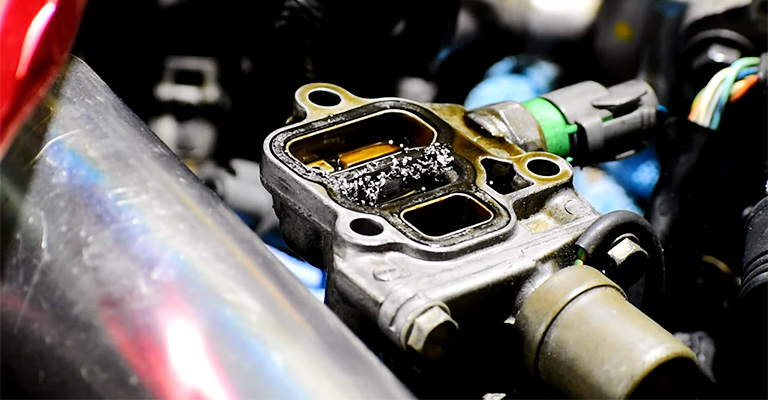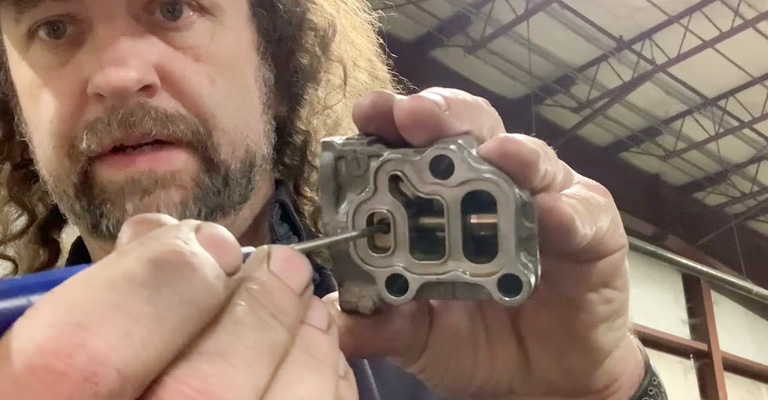You might be wondering what does the VTEC solenoid do? And that’s why you’re here!
The Honda VTEC (Variable Valve Timing and Lift Electronic Control) system is a well-known technology in the world of automotive engineering, known for its ability to enhance engine performance and efficiency.
At the heart of this system lies the VTEC solenoid, a crucial component that plays a critical role in the operation of the VTEC system.
In this article, we’ll delve into the inner workings of this solenoid and explore its function, importance, and how it impacts the overall performance of your Honda engine.
Whether you’re a car enthusiast or just curious about how your vehicle works, this article will give you a comprehensive understanding of the VTEC solenoid and its role in modern automotive technology.

What Does the VTEC Solenoid Do?
The VTEC (Variable Valve Timing and Lift Electronic Control) solenoid is an electronic component used in Honda engines to control the operation of the VTEC system.
Even the main function of the solenoid is to control the flow of oil to the VTEC rocker arm, which activates the mechanism in Honda engines.
Moreover, this solenoid is responsible for controlling the activation of the VTEC system. This allows the engine to switch between different cam profiles depending on driving conditions to improve performance and efficiency.
When the system is not in use, the solenoid restricts oil flow to the rocker’s arm, allowing the engine to run on a less aggressive cam profile.
That’s not all; when this system is activated, the solenoid opens up, allowing oil to flow freely to the rocker’s arm, causing the mechanism to switch to a higher-performance cam profile.
In addition, the solenoid helps regulate the oil pressure within the engine, ensuring proper operation of the VTEC system and preventing damage to the engine components. It also helps maintain a consistent engine speed and reduces emissions.
Overall, the VTEC solenoid plays a critical role in the operation of the system. Proper maintenance and functioning of this solenoid are essential for the optimal performance and efficiency of the Honda engine.
What Is the Location of the VTEC Solenoid?

The location of the Variable Valve Timing and Lift Electronic Control solenoid can vary depending on the specific Honda engine model. However, it is typically located near the top of the engine block or near the intake camshaft.
In some Honda engines, the solenoid is integrated into the oil control valve assembly and can be found near the oil filter. It may be located in a separate housing near the camshaft or valve cover in other engines.
It is important to consult your Honda engine’s service manual or owner’s manual for the exact location of the VTEC solenoid in your specific vehicle.
An authorized Honda dealer or a qualified mechanic can also help you locate this solenoid and provide more information on its function and maintenance.
Can VTEC Solenoid Go Bad? Reasons Explained

Yes, the VTEC (Variable Valve Timing and Lift Electronic Control) solenoid can go bad. Some of the common reasons for the solenoid to malfunction include:
Clogging: Dirt and debris can clog the solenoid, which can cause it to stick or fail to function properly. This can result in reduced engine performance and decreased fuel efficiency.
Wear and tear: Over time, the solenoid can become worn due to normal wear and tear, especially if the engine is not properly maintained. This can cause the solenoid to become less effective or stop functioning altogether.
Electrical issues: The VTEC solenoid is controlled by an electrical signal from the engine’s control module. If there are electrical issues with the control module or wiring, this solenoid may not function properly.
Oil pressure problems: The VTEC solenoid is responsible for regulating the oil pressure in the engine. If there are issues with the engine’s oil pressure, the VTEC solenoid may not function properly.
Engine oil problems: The VTEC solenoid is lubricated by the engine oil. If the engine oil is dirty or has the wrong viscosity, it can cause the solenoid to fail or malfunction.
If you suspect that your solenoid is not functioning properly, it is important to have it inspected and diagnosed by an authorized Honda dealer or a qualified mechanic.
A malfunctioning solenoid can result in decreased engine performance and reduced fuel efficiency and can cause damage to other engine components if left untreated.
What Are the Symptoms of a Bad VTEC Solenoid?

A bad VTEC (Variable Valve Timing and Lift Electronic Control) solenoid can cause a variety of symptoms, including:
Engine misfire: If the solenoid is malfunctioning, it can cause an engine misfire that can be felt as a rough or jerky movement while driving.
Reduced engine performance: A bad solenoid can cause decreased engine performance, such as a decrease in power and acceleration.
Check Engine Light: The VTEC solenoid is monitored by the engine control module, and if it malfunctions, the Check Engine Light may illuminate.
Poor fuel efficiency: A malfunctioning solenoid can cause poor fuel efficiency, as the engine will not be able to operate at its most efficient setting.
Engine oil leaks: If this solenoid is damaged, it may cause engine oil to leak, which can lead to further engine damage.
How to Fix a Bad VTEC Solenoid?
Fixing a bad VTEC solenoid depends on the specific issue causing the malfunction. Here are some steps that can be taken to fix a bad VTEC solenoid:
Clean the VTEC solenoid

If the solenoid is clogged with dirt or debris, it can be cleaned with a solvent or brake cleaner. However, this should only be done by a qualified mechanic as the solenoid is a delicate component, and cleaning it improperly can cause further damage.
Replace the VTEC solenoid
If the solenoid is worn or damaged, it will need to be replaced. A qualified mechanic can remove the old solenoid and install a new one.
Repair electrical issues
If there are electrical issues with the engine’s control module or wiring, they will need to be repaired to fix the VTEC solenoid. An authorized Honda dealer or a qualified mechanic can diagnose and repair these issues.
Fix oil pressure problems
If there are issues with the engine’s oil pressure, they will need to be addressed in order to fix the solenoid. This may involve changing the engine oil or repairing other components within the engine.
Use the correct engine oil
Using the correct viscosity and type of engine oil is important for maintaining proper VTEC solenoid function. An authorized Honda dealer or a qualified mechanic can recommend the correct type of oil for your engine.
How to Keep VTEC Solenoid Good?
So far, you’ve known how important the VTEC solenoid is for your vehicle.
Here are some steps you can take to keep your solenoid in good condition:
Regular oil changes
Keeping your engine oil clean and fresh is important for maintaining the health of your VTEC solenoid and other engine components. Regular oil changes will help reduce wear and tear on the solenoid and other engine parts.
Avoid excessive idling
Excessive idling can put a strain on the VTEC solenoid. Avoid letting your car idle for extended periods, and drive at moderate speeds whenever possible.
Use high-quality engine oil
Using high-quality engine oil formulated for your specific vehicle can help reduce wear and tear on the solenoid.
Regular tune-ups
Regular tune-ups, which typically include a check of the engine control system, can help to ensure that your VTEC solenoid is functioning properly. A qualified mechanic can diagnose any issues and make any necessary repairs.
Avoid harsh driving conditions
Avoiding harsh driving conditions, such as excessive high-speed driving, can also prevent wear and tear on the solenoid.
By following these steps, you can help keep your VTEC solenoid in good condition and ensure that your vehicle runs at its best.
If you notice any symptoms of a bad solenoid, it’s important to diagnose and repair it as soon as possible to avoid further damage to your engine.
Frequently Asked Questions
The cost to repair a VTEC solenoid can vary depending on several factors, including Location, Make and model of the vehicle, Severity of the issue, and Independent vs dealership.
Typically, the cost to repair this solenoid can range from $200 to $800, but the exact cost will depend on the factors listed above.
It’s always a good idea to get an estimate from a qualified mechanic before any repairs so you know what to expect in terms of cost.
The cost of a VTEC solenoid depends on the make and model of your vehicle and whether you purchase the solenoid from a dealership or an aftermarket supplier.
On average, the cost of this solenoid can range from $100 to $300, but the exact cost will depend on the factors mentioned above.
Higher-end vehicles and luxury vehicles will typically have a higher cost for the VTEC solenoid, as the parts and components are often more expensive.
A bad VTEC solenoid can trigger a number of error codes, which can be displayed on the vehicle’s onboard diagnostic system.
Some of the most common error codes related to a bad VTEC solenoid include P1259, P2646, P1457, P1399, and P2647.
If you are experiencing any of these error codes, it is important to have your vehicle inspected by a qualified mechanic to diagnose the issue and determine the best course of action.
The Bottom Line
In conclusion, we hope you’ve understood what the VTEC solenoid does and its critical role in the engine control system of modern vehicles.
Whether you’re an experienced mechanic or a vehicle owner, knowing about this solenoid can help you keep your vehicle in top condition for years to come.
If you’re experiencing any issues with your VTEC system or hearing strange noises from your engine, it’s best to have your vehicle inspected by a qualified mechanic as soon as possible.

Leave a Reply